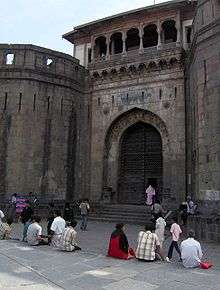Baji Rao I
Baji Rao I (18 August 1700 – 28 April 1740[3]) was a general of the Maratha Empire in India. He served as the Peshwa to the 4th Maratha Chhatrapati (Emperor) Shahu from 1720 until his death. Bajirao was Peshwa in the Ashta Pradhan (8-minister council) of Shahu. He is also known by the name Bajirao Ballal.[4]
Baji Rao I Ballāḷa[2] | |
|---|---|
 | |
| Peshwa of the Maratha Empire | |
| In office 17 April 1720 – 28 April 1740 | |
| Monarch | Chhatrapati Shahu |
| Preceded by | Balaji Vishwanath |
| Succeeded by | Balaji Bajirao |
| Personal details | |
| Born | 18 August 1700 Dubere, Sinnar, Maratha Empire (present-day Nashik district, Maharashtra, India) |
| Died | 28 April 1740 (aged 39) Raverkhedi, Maratha Empire (present-day Khargone district, Madhya Pradesh, India) |
| Spouse(s) | |
| Relations |
|
| Children |
|
| Mother | Radhabai Barve |
| Father | Balaji Vishwanath |
Bajirao I is credited with expanding the Maratha Empire in India. Maratha Empire reached its zenith later on under reign of Chhatrapati Shahu and Bajirao. He was one of the major contributors in expansion over the Indian subcontinent. In his military career spanning 20 years, Bajirao I never lost a single battle.
Early life
Bajirao was born into the Bhat family in Sinnar.[5] His father Balaji Vishwanath was a Peshwa of Chhatrapati Shahu; his mother was Radhabai Barve.[6] Baji Rao had a younger brother Chimaji Appa and two sisters, Bihubai Joshi and Anubai Ghorpade.[3] The eldest of his sisters were married into a Deshastha family.[7] He spent his childhood in his father's newly acquired fiefdom of Saswad.
Bajirao would often accompany his father on military campaigns. He was with his father when the latter was imprisoned by Damaji Thorat before being released for a ransom.[3] When Vishwanath died in 1720, Chhatrapati Shahu appointed the 20-year-old Baji Rao as the Peshwa despite opposition from other chieftains.[8] He is said to have preached the ideal of Hindu Pad Padshahi (Hindu Empire).[9]
Bajirao intended to plant the Maratha flag upon the walls of Delhi and other cities governed by the Mughals and their subjects. He intended to replace the Mughal Empire and create a Hindu-Pat-Padshahi.[10]
Early Life as a Peshwa
The twenty year old Bajirao was appointed as Peshwa in succession to his father by Chhatrapati Shahu on 17 April 1720. By the time of Baji Rao's appointment, Mughal emperor Muhammad Shah had in 1719 recognized Marathas' rights over the territories possessed by Shivaji at his death. The treaty also included the Maratha rights to collect taxes (chauth or chauthai and sardeshmukhi) in the six provinces of Deccan.[11] Bajirao succeeded in convincing Chatrapati Shahu that if we want to defend the Maratha Empire then we have to be offensive on our enemy.[12] Bajirao believed that the Mughal Empire was in decline and wanted to take advantage of this situation with aggressive expansion in North India. Sensing the declining fortune of the Mughals, he is reported to have said:
Strike, strike at the roots and whole tree will also fall down. Listen but to my counsel and I shall plant the Maratha Flag on the walls of Attock(Fort).[13][12][14]
However, as a new Peshwa, he faced several challenges:[3]
- His appointment as the Peshwa at a young age had evoked jealousy from senior officials like Naro Ram Mantri, Anant Ram Sumant and Shripatrao Pant Pratinidhi. This led Bajirao to promote as commanders young men like himself who were barely out of teens such as Malhar Rao Holkar, Ranoji Shinde and the Pawar brothers. Also, these men did not belong to families that held hereditary Deshmukhi rights under the Deccan Sultanates.[15]
- The Mughal viceroy of Deccan Nizam-ul-Mulk Asaf Jah I, had practically created his own independent kingdom in the region. He challenged Shahu's right to collect taxes in Deccan[16] on the pretext that he did not know whether Chhatrapati Shahu or his cousin Sambhaji II of Kolhapur were the rightful heir to the Maratha throne.[3]
- The Marathas needed to assert their rights over the nobles of the newly gained territories in Malwa and Gujarat.[3]
- Several areas that were nominally part of the Maratha territory, were not actually under Peshwa's control. For example, the Siddis controlled the Janjira fort.[3]
Campaign against the subjects of the Mughal Empire
Campaign against the Nizam
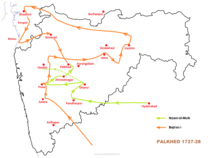
On 4 January 1721, Baji Rao met Nizam-ul-Mulk Asaf Jah I at Chikhalthana to settle their disputes through agreement. However, Nizam refused to recognize the Maratha rights to collect taxes from the Deccan provinces.[3] Nizam was made Vizier of Mughal Empire in 1721, but alarmed at his growing power, emperor Muhammad Shah transferred him from Deccan to Awadh in 1723. Nizam rebelled against the order, resigned as the Vizier and marched towards Deccan. The emperor sent an army against him, which the Nizam defeated in the Battle of Sakhar-kheda. In response, Mughal emperor was forced to recognize him as the viceroy of Deccan. The Marathas, led by Bajirao, helped Nizam win this battle. In fact, for his bravery in the battle, Baji Rao was honored with a robe, a mansabdari of 7,000, an elephant and a jewel. After the battle, Nizam tried to appease both the Maratha Chhatrapati Shahu as well as the Mughal emperor. However, in reality, he wanted to carve out a sovereign kingdom and considered the Marathas his rivals in the Deccan.[17]
In 1725, Nizam sent an army to clear out the Maratha revenue collectors from the Carnatic region. The Marathas dispatched a force under Fateh Singh Bhosle to counter him; Baji Rao accompanied Bhosle, but did not command the army. The Marathas were forced to retreat. They launched a second campaign after the monsoon season, but once again, they were unable to prevent the Nizam from ousting the Maratha collectors.[16]
Meanwhile, in Deccan, Sambhaji II of Kolhapur State had become a rival claimant to the title of the Maratha Chhatrapati. Nizam took advantage of this dispute among the Marathas. He refused to pay the chauth or sardeshmukhi on the grounds that it was unclear who was the real Chhatrapati: Shahu or Sambhaji II (and therefore, to whom the payment needed to be made). Nizam offered to act as an arbitrator in this dispute. At Shahu's court, Shripatrao Pant Pratinidhi advised Shahu to open negotiation and relinquish to the arbitration of Nizam. At the court of Sambhaji II, his supporter was Chandrasen Jadhav, who had fought Bajirao's father a decade earlier. Bajirao convinced Shahu not to accept Nizam's arbitration offer and instead launch an assault against him.[16][18]
Nizam invaded Pune, where he installed Sambhaji II as Chhatrapati. He then marched out of the city, leaving behind a contingent headed by Fazal Beg. Nizam plundered Loni, Pargaon, Patas, Supa and Baramati by means of his efficient artillery. Seeing this, on 27 August 1727, Baji Rao started a retaliatory attack through guerrilla warfare against Nizam with his trusted lieutenants Malhar Rao Holkar, Ranoji Shinde and Pawar brothers. He started to destroy the towns owned by Nizam. Leaving Pune he crossed Godavari river near Puntamba and plundered Jalna and Sindkhed. From there, Bajirao proceeded and destroyed Berar, Mahur, Mangrulpir and Washim. From there, he suddenly changed his direction to north-west, reached Khandesh and then crossed Tapi river at Kokarmunda and then through a great speed entered the east of Gujarat to Chota Udaipur in January 1728. After hearing that Nizam turned to Pune, Bajirao feinted that he would devastate Burhanpur. Bajirao rightly calculated that after hearing the news of devastation of Burhanpur, Nizam will turn to save Burhanpur as it was strategically important to Nizam. But Bajirao didn't entered Burhanpur, rather he proceeded to Betawad in Khandesh and reached Betawad on 14 February 1728.[19] When Nizam heard that his northern territories have been devastated by Bajirao, he left Pune and marched towards Godavari with an objective of destroying Bajirao in an open plain where his artillery can be effectively used. But in order to carry out swift movements he left his unwieldy artillery behind and crossed Godavari to find Bajirao. On 25 February 1728, the armies of Bajirao and Nizam faced each other at the Palkhed, a town about 30 miles west of Aurangabad. Here he was quickly surrounded by Maratha forces. Nizam suddenly found himself trapped. His supply and communication was entirely cut off and he soon found it impossible to extricate himself and escape to a place of safety. Nizam was defeated and forced to make peace. On 6 March, he signed the Treaty of Mungi Shevgaon, recognizing Shahu as the Chhatrapati as well as the Maratha right to collect taxes in Deccan.[3][20]
Baji Rao moved his base of operations from Saswad to Pune in 1728 and in the process laid the foundation for turning what was a kasba into a large city.[21] Bajirao also started construction of Shaniwar Wada on the right bank of the Mutha River. The construction was completed in 1730, ushering in the era of Peshwa control of the city.
Malwa campaign

In 1723, Baji Rao had organized an expedition to the southern parts of Malwa. The Maratha chiefs such as Ranoji Shinde, Malhar Rao Holkar, Udaji Rao Pawar, Tukoji Rao Pawar and Jivaji Rao Pawar had successfully collected chauth from several areas in Malwa.(Later, these chiefs carved out their own kingdoms of Gwalior, Indore, Dhar and Dewas States- Junior and Senior respectively). To counter the Maratha influence, Mughal emperor had appointed Girdhar Bahadur as the Governor of Malwa.[3]
After defeating Nizam, Baji Rao turned his attention towards Malwa. In October 1728, he consigned a huge army commanded by his younger brother Chimaji Appa, and aided by his trusted generals like Shinde, Holkar and Pawar. On 29 November 1728, Chimaji's army defeated the Mughals at the Battle of Amjhera. Girdhar Bahadur and his commander Daya Bahadur were killed in the battle. Chimaji also marched towards Ujjain, but had to retreat due to lack of supplies.[3] By February 1729, the Maratha forces had reached the present-day Rajasthan.[16]
Bundelkhand campaign
In Bundelkhand, Chhatrasal had rebelled against the Mughal empire and established an independent kingdom. In December 1728, a Mughal force led by Muhammad Khan Bangash attacked him and besieged his fort with his family. Chhatrasal had repeatedly sought Bajirao's assistance, but the latter was busy in Malwa at that time. In March 1729, Peshwa finally responded to Chhatrasal's request and marched towards Bundelkhand with 25000 horsemen with his trusted lieutenants Pilaji Jadhav, Tukoji Pawar and Davalji Somwanshi.[22] Chhatrasal also escaped his captivity and joined the Maratha force and the joint army went up to 70000 men.[23] After they marched to Jaitpur, Bajirao's forces surrounded Bangash and cut his supply and communication lines where he was encamped. Bangash made a counterattack on the forces of Bajirao but he was unable to pierce Bajirao's defences. Qaim Khan, son of Muhammad Khan Bangash, came to know of his father's condition and he came with fresh troops. But his force was attacked by Bajirao's forces and Qaim Khan was defeated. Later Muhammad Khan Bangash was forced to leave and signed an agreement that "he will never attack Bundelkhand again".[24][25] Chhatrasal's position as the ruler of Bundelkhand was restored. Chhatrasal assigned a large jagir to Baji Rao and also married his daughter Mastani to him. Before his death in December 1731, he ceded one-third of his territories to the Marathas.[3]
Gujarat campaign
After consolidating Maratha influence in central India, Peshwa Baji Rao decided to assert Maratha rights to collect taxes from the rich province of Gujarat. In 1730, he sent a Maratha force under Chimaji Appa to Gujarat. Sarbuland Khan, the Mughal Governor of the province, ceded to Marathas, the right to collect chauth and sardeshmukhi from Gujarat. He was soon replaced by Abhay Singh, who also recognized the Maratha rights to collect taxes. However, this success irked Chhatrapati Shahu's senapati(commander-in-chief) Trimbak Rao Dabhade. His ancestors from Dabhade clan had raided Gujarat several times, asserting their rights to collect taxes from that province. Annoyed at Bajirao's control over what he considered his family's sphere of influence, he rebelled against the Peshwa.[3] Two other Maratha nobles of Gujarat – Gaekwad and Kadam Bande – also sided with Dabhade.[16]
Meanwhile, after the defeat of Girdhar Bahadur in 1728, the Mughal emperor had appointed Jai Singh II to subdue the Marathas. However, Jai Singh recommended a peaceful agreement with the Marathas. The emperor disagreed and replaced him with Muhammad Khan Bangash. Bangash formed an alliance with the Nizam, Trimbak Rao and Sambhaji II. On 1 April 1731, Baji Rao defeated the allied forces of Dabhade, Gaekwad and Kadam Bande: Trimbak Rao was killed in the Battle of Dabhoi. On 13 April, Baji Rao resolved the dispute with Sambhaji II by signing the Treaty of Warna, which demarcated the territories of Chhatrapati Shahu and Sambhaji II. Subsequently, the Nizam met Baji Rao at Rohe-Rameshwar on 27 December 1732 and promised not to interfere with the Maratha expeditions.[3]
Even after subduing Trimbak Rao, Shahu and Baji Rao avoided a rivalry with the powerful Dabhade clan: Trimbak's son Yashwant Rao was made the new senapati of Shahu. Dabhade family was allowed to continue collecting chauth from Gujarat on the condition that they would deposit half the collections in the Chhatrapati Shahu's treasury.[3]
Campaign against Siddis
The Siddis of Janjira controlled a small but strategically important territory on the western coast of India. They originally held only the Janjira fort, but after Shivaji's death, they had expanded their rule to a large part of the central and northern Konkan region.[16] After the death of the Siddi chief Yakut Khan in 1733, a war of succession broke out among his sons. One of his sons, Abdul Rehman, requested Baji Rao for help. Baji Rao sent a Maratha force led by Sekhoji Angre(son of Kanhoji Angre). The Marathas regained control of several places in Konkan and besieged Janjira. However, their strength was diverted after Peshwa's rival Pant Pratinidhi occupied the Raigad Fort near Janjira in June 1733. In August, Sekhoji Angre died, further weakening the Maratha position. As a result, Baji Rao decided to sign a peace treaty with the Siddis. He allowed the Siddis to retain control of Janjira on the condition that they would accept Abdul Rehman as the ruler. The Siddis were also allowed to retain control of Anjanvel, Gowalkot and Underi. The Marathas retained the territories of Raigad, Rewas, Thal and Chaul, which they had gained during the offensive.[3]
Soon after the Peshwa marched back to Satara, the Siddis launched an offensive to regain their lost territories. In June 1734, Bajirao dispatched a force to prevent them from taking over the Raigad fort. Subsequently, on 19 April 1736, Chimnaji launched a surprise attack on a Siddi camp near Rewas, killing around 1,500 of them, including their leader Siddi Sat. On 25 September, the Siddis signed a peace treaty, which confined them to Janjira, Gowalkot and Anjanvel.[3]
March to Delhi
After death of Trimbak Rao, Bangash's alliance against the Marathas had fallen apart. Consequently, Mughal emperor recalled him from Malwa, and re-appointed Jai Singh II as the governor of Malwa. However, Maratha chief Holkar defeated Jai Singh in the Battle of Mandsaur in 1733. After two more battles, Mughals decided to offer Marathas the right to collect ₹ 22 lakh as chauth from Malwa. On 4 March 1736, Baji Rao and Jai Singh came to an agreement at Kishangad. Jai Singh convinced the emperor to agree to the plan and Baji Rao was appointed as Deputy Governor of the province. Jai Singh is also believed to have secretly informed Bajirao that it was a good time to subdue the weakening Mughal emperor.[3]
On 12 November 1736, the Peshwa started a march to the Mughal capital Delhi from Pune with a force of 50,000 cavalrymen.[26] On hearing about the advancing Maratha army, Mughal emperor asked Saadat Ali Khan I to march from Agra and check the Maratha advance. The Maratha chiefs Malhar Rao Holkar and Pilaji Jadhav crossed Yamuna and plundered the Mughal territories in the Ganga-Yamuna Doab. Saadat Khan led a force of 150,000 against them, and defeated them. He then retired to Mathura, thinking that the Marathas had retreated. However, Baji Rao advanced to Delhi and encamped at Talkatora. Avoiding direct Agra-Delhi route, Baji Rao moved stealthily through the hilly route of the Jats and Mewatis and appeared before the Delhi.[27] The Mughal emperor dispatched a force led by Mir Hasan Khan Koka to check his advance. The Marathas defeated this force in the Battle of Delhi on 28 March 1737. Baji Rao then retreated from Delhi, apprehensive about the approach of a larger Mughal force from Mathura.[3] The following excerpt from the letter written by Bajirao to his brother Chimaji Appa from Jaipur on 5 April 1737, enlighten more on what exactly happened in Delhi:
I was resolved to let the Emperor know that I was still in Hindustan and to show him that we Marathas can come to the gates of Delhi. I reached Delhi on 28 (28 March 1737) and encamped outside the city. I gave up the idea of setting fire to the adjoining suburbs, considering it a desecration to commit such a unruly outrage upon the ancient city. March 29 happened to be the day of Lord Rama's birth, for which celebrations are going on in the city. We carried a light plunder in the celebration. This was enough to strike terror (in the mind of Mughal Emperor). We withdrew our position away from the city and encamped at Jhil Lake. Emperor sent a force of 8000 to drive us away. Our sardars, Holkar, Shinde and Pawar brothers faced them gallantly and defeated them. A dozen of Mughal officers were killed, Mir Hasan Khan Koka was wounded and several others fled away to save their lives. Our own loss was insignificant. On 31 March we received information that combined Mughal army was coming on us. In order to draw them away we marched towards Rewari and Kotputli and now we hear that the Emperor had called his army back. Now we are heading towards Gwalior for collecting the overdues. If Nizam-ul-Mulk tries to cross the Narmada and come to the help of Emperor, you must prevent him and harass him as previously advised. It will be better if Nizam is held in check. On this side none is to be afraid of. Such is the outcome of this great offensive.[28][29][30]
The Mughal emperor Muhammad Shah then sought help from Nizam. Nizam set out from Deccan and met Baji Rao's returning force at Sironj. Nizam told Baji Rao that he was going to Delhi to repair his relationship with the Mughal emperor. On reaching Delhi, he was joined by other Mughal chiefs and a massive Mughal army set out against the Peshwa. Peshwa also assembled a force of 80,000 soldiers and marched towards Delhi, leaving behind a force of 10,000 under Chimaji Appa to guard Deccan. The two armies met mid-way at Bhopal, where the Marathas defeated the Mughals in the Battle of Bhopal on 24 December 1737. Once again, Nizam was forced to sign a peace agreement, this time at Doraha on 7 January 1738.[31] The province of Malwa was formally ceded to the Marathas and the Mughals agreed to pay ₹ 5,000,000 as indemnity. This time, Nizam took an oath on Quran to abide by the treaty.[3]
Campaign Against the Portuguese
The Portuguese had captured several territories on the west coast of India. They had violated an agreement to give the Marathas a site on Salsette Island for building a factory and had been practising religious intolerance against Hindus in their territory. In March 1737, Peshwa dispatched a Maratha force led by Chimaji against them. Marathas captured the Ghodbunder Fort and almost all of Vasai, after the Battle of Vasai. They also managed to gain control of Salsette on 16 May 1739, after a prolonged siege. However, the Marathas had to turn their attention away from the Portuguese due to Nader Shah's invasion of the Mughal Empire in north India.[3]
Personal life
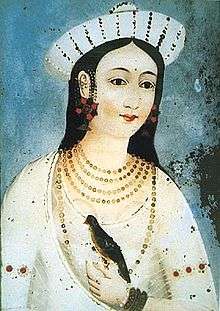
Bajirao's first wife was Kashibai. She was the daughter of Mahadji Krishna Joshi and Shiubai of Chas, a wealthy banker family.[32] The relationship between the couple was a happy one.[33][34] They had three sons together: Balaji Baji Rao (also called "Nanasaheb"), Raghunath Rao (also called "Ragoba") and Janardhan Rao (who died young).[35] Nanasaheb was appointed as Peshwa by Chhatrapati Shahu in 1740, succeeding his father.
He took a second wife, Mastani. She was the daughter of the Hindu king Chhatrasal of Bundelkhand from his Muslim wife. The marriage was purely a political one and was accepted out of regard for the sentiments of the Bundela king.[33] In 1734, Mastani bore a son who was to be named Krishna Rao at birth. Being born of a Muslim mother, the priests refused to conduct the Hindu upanayana ceremony for him.[3] The boy was eventually named Shamsher Bahadur and brought up as a Muslim.
After Baji Rao's and Mastani's deaths in 1740, Kashibai took the 6-year-old Shamsher Bahadur under her care and raised him as one of her own. Shamsher was bestowed upon a portion of his father's dominion of Banda and Kalpi. In 1761, he and his army contingent fought alongside the Peshwa in the Third Battle of Panipat between the Marathas and Afghans. He was wounded in that battle and died a few days later at Deeg.[36][37][38][39]
Death
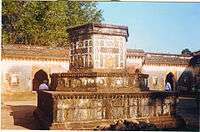
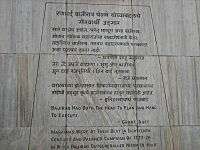
Baji Rao came down with a sudden fever on 23 April 1740 and after a short period of illness, died on 28 April that same year. At that time, he was in a camp in Raverkhedi.[40] He was cremated on the same day at Raverkhedi on Narmada River. Sir Richard Temple in his book Oriental Experience said the following about Baji Rao and quoting him:
He died, as he lived, in the camp under canvas among his men; and he is remembered to this day among Marathas as the fighting Peshwa, as the incarnation of Hindu energy.
— Sir Richard Temple, Oriental Experience (1883)[41]
The Scindias built a chhatri as a memorial at this place. The memorial is enclosed by a dharmashala. The compound has two temples, dedicated to Nilkantheshwara Mahadeva(Shiva) and Rameshvara(Rama).[42]
Battle tactics and Character
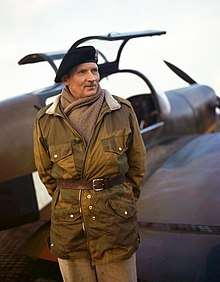
Baji Rao was renowned for rapid tactical movements in battle, using his cavalry, inherited from Maratha generals like Santaji Ghorpade and Dhanaji Jadhav. Two examples are the Battle of Palkhed in 1728 when he outmaneuvered the Mughal Governor of Deccan province and again in the battle against the Mughal Emperor Muhammad Shah at Delhi during 1737. His skill lie in manoeuvering of a huge cavalry with a great speed.[43] British Field Marshal Bernard Montgomery, likened Bajirao's war tactics in the Palkhed campaign: the use of rapid movement where his troops lived off the land, with minimal concern for their own supply and communication lines and employing "total warfare" on the enemy civilian population. Field Marshal Montgomery in his book A Concise History of Warfare wrote the following about Bajirao's victory at Palkhed:
They(Marathas) were at their best in the eighteenth century, and the Palkhed campaign of 1727-28 in which Baji Rao I outgeneralled Nizam-ul-Mulk, is a masterpiece of strategic mobility. Baji Rao's army was a purely mounted force, armed only with sabre, lance, a bow in some units and a round shield. There was a spare horse for every two men. The Marathas moved unencumbered by artillery, baggage, or even handguns and defensive armour. They supplied themselves by looting.[44]
Montgomery further writes:
Baji Rao resented the Nizam's rule over the Deccan and it was he who struck the first blow. In October 1727, as soon as rainy season ended, Baji Rao burst into the territories of Nizam. The lightly equipped Marathas moved with great rapidity, avoiding the main towns and fortresses, living off the country, burning and plundering. They met one reverse at the hands of Nizam's able lieutenant, Iwaz Khan, at the beginning of November 1727, but within a month they had fully recovered and were off again, dashing east, north, west, with sudden changes in direction.[45]
Sir Jadunath Sarkar called him "a heavenly-born cavalry leader".[43]
Baji Rao concentrated on using local terrain to cut the enemy supply-lines with the help of his rapid troop movement. Always leading from the front, he followed Maratha traditional tactics of encircling the enemy quickly, appearing from the rear of the enemy, attacking from the unexpected direction, distracting the enemy's attention, keeping the enemy off balance and deciding the battlefield on his own terms. Bajirao kept minute information of the enemy forces to himself and then attacking the enemy from unexpected direction just to cause a sense of fear in them.[43]
James Grant Duff in his book A History of the Mahrattas praised Baji Rao and said:
It may be truly said that Baji Rao had both, the head to plan and the hand to execute.[46]
Deep Singh, the special envoy of Rajah of Jaipur after visiting Satara at Chatrapati Shahu's court is reported to have said:
Baji Rao is the only true leader of men among Marathas. With exception of Baji Rao he could see no statesman true of his word, trusted by his Sovereign, beloved by his troops and capable of shouldering heavy responsibilities.[47][48]
When Chatrapati Shahu appointed Balaji Baji Rao the eldest son of Bajirao as Peshwa, he instructed Balaji Bajirao with the following instructions:
Baji Rao served the state loyally on the lines laid down by his father and expanded the Maratha dominions by means of many heroic deeds. His ambition was to guard the Mughal Empire and at the same time to conquer all Hindustan. You are his son; realise your father's ambition. Lead your horsemen beyond the walls of Attock.[49][50]
The stature of Peshwa Baji Rao at Chatrapati Shahu's court can be understood from the following paragraph of letter written by Captain William Gordon dated 21 July 1739. He wrote:
I have throughout the foregoing hinted at the power of Baji Rao, who will always be capable of causing unsuccessful any application made to the Shahu Raja, and probably show his resentment at the place; so that although a civil correspondence with the said Raja may not be amiss, care must be taken that he is not solicited for what interferes with Baji Rao, whose authority at the court is even such, that in absence of the Raja, and contrary to the advice of seven principal Counsellors, he can enforce a complete obedience to his soul mates.[51]
In popular culture
- 1972 – Rau, the fictional Marathi novel by Nagnath S. Inamdar featuring a fictionalized love story between Baji Rao I and Mastani.[52]
- In 2015, historical drama film Bajirao Mastani directed by Sanjay Leela Bhansali, Bajirao is portrayed by Ranveer Singh.[53]
- In 2017, a TV series titled Peshwa Bajirao aired on Sony TV starring Rudra Soni in the role of young Bajirao and Karan Suchak as Bajirao.[54]
See also
References
- Javlekar, Arvind (2005). Lokmata Ahilyabai. Ocean Books (P)Ltd. ISBN 9788188322084.
- Heitzman, James (2008). The City in South Asia. Routledge. p. 97. ISBN 9781134289639.
- G.S.Chhabra (2005). Advance Study in the History of Modern India (Volume 1: 1707–1803). Lotus Press. pp. 19–28. ISBN 978-81-89093-06-8.
- Gokhale, Sandhya (2008). The Chitpavans: social ascendancy of a creative minority in Maharashtra, 1818–1918. Shubhi. p. 82. ISBN 978-81-8290-132-2.
- Valentine, Sir Chirol (2012). Indian Unrest. tredition. p. 72. ISBN 978-3-8472-0599-9.
- Barave, Dinakara Dattātraya; Barve (Barave) Kula Snehasãvardhaka Maṇḍaḷa (2007). Barave (Barve) gharāṇyācā kulavr̥ttānta. p. 471. OCLC 824536402.
- The Struggle for Hindu supremacy. Shri Bhagavan Vedavyasa Itihasa Samshodhana Mandira (Bhishma). 1992. p. 194. ISBN 9788190011358.
- Shripad Rama Sharma (1951). The Making of Modern India: From A. D. 1526 to the Present Day. Orient Longmans. p. 239.
- B.N. Puri; M.N. Das (2003). A Comprehensive History of India: Comprehensive history of medieval India. Sterling. p. 212. ISBN 978-81-207-2508-9.
- Agrawal, Ashvini (1983). Studies in Mughal History. Motilal Banarsidass. p. 23. ISBN 978-81-208-2326-6.
- Mehta, Jaswant Lal (2005). Advanced Study in the History of Modern India: 1707 – 1813. New Delhi: New Dawn Press. pp. 492–494. ISBN 9781932705546.
- G.S.Chhabra (2005). Advance Study in the History of Modern India (Volume 1: 1707–1803). Lotus Press. p. 20. ISBN 978-81-89093-06-8.
- S. N. Sen (2006). History Modern India. New Age International. p. 11. ISBN 978-81-224-1774-6.
- Srinivasan, C.K (1961). Baji Rao I The Great Peshwa. Asia Publishing House, New Delhi. p. 27.
- Gordon, Stewart (2008). The Marathas 1600–1818 (Digitally print. 1. pbk. version. ed.). Cambridge [u.a.]: Cambridge Univ Pr. pp. 117–121. ISBN 978-0521033169.
- Gordon, Stewart (1993). The Marathas 1600–1818. Cambridge University Press. pp. 120–131. ISBN 978-0-521-26883-7.
- P. V. Kate (1987). Marathwada Under the Nizams, 1724–1948. Mittal. pp. 11–13. ISBN 978-81-7099-017-8.
- Dighe, V.G. (1944). PESHWA BAJIRAO I AND MARATHA EXPANSION. Karnatak Publishing House. p. 18.
- Sardesai, Govind Sakharam. New History of Marathas (1707-1772). Phoenix Publications. pp. 96, 97.
- Sardesai, Govind Sakharam. New History of Marathas (1707-1772). Phoenix Publications. p. 98.
- Kosambi, Meera (1989). "Glory of Peshwa Pune". Economic and Political Weekly. 24 (5): 247.
- Sardesai, Govind Sakharam. New History of The Marathas(1707-1772). Phoenix Publications. p. 106.
- Dighe, V.G. (1944). PESHWA BAJIRAO I AND MARATHA EXPANSION. Karnatak Publishing House. p. 106.
- Sardesai, Govind Sakharam. New History of The Marathas(1707-1772). Phoenix Publications. pp. 106, 107.
- Dighe, V.G. (1944). PESHWA BAJIRAO I AND MARATHA EXPANSION. Karnatak Publishing House. pp. 107, 108.
- Dighe, V.G. (1944). PESHWA BAJIRAO I AND MARATHA EXPANSION. Karnatak Publishing House. p. 130.
- Dighe, V.G. (1944). PESHWA BAJIRAO I AND MARATHA EXPANSION. Karnatak Publishing House. p. 134.
- Dighe, V.G. (1944). PESHWA BAJIRAO I AND MARATHA EXPANSION. Karnatak Publishing House. pp. 134, 135.
- Sardesai, Govind Sakharam. New History of Marathas (1707-1772). Phoenix Publications. pp. 153, 154.
- Kincaid and Parasnis. A History of the Maratha People(Vol 2). Humphrey Milford. pp. 226, 229.
- S.R. Bakshi and O.P. Ralhan (2007). Madhya Pradesh Through the Ages. Sarup & Sons. p. 384. ISBN 978-81-7625-806-7.
- Gokhale, Sandhya (2008). The Chitpavans: social ascendancy of a creative minority in Maharashtra, 1818–1918. Sandhya Gokhale. p. 82. ISBN 9788182901322.
- Mehta, J. L. (2005). Advanced study in the history of modern India, 1707–1813. Slough: New Dawn Press, Inc. p. 124. ISBN 9781932705546.
- Mishra, Garima (3 January 2016). "Tracing Kashibai: The 'first' lady from Bhansali's Bajirao Mastani". The Indian Express. Retrieved 30 July 2017.
- B. P. Saha (1997). Begams, concubines, and memsahibs. Vikas. p. 88.
- Dodwell, Henry (1958). The Cambridge History of India: Turks and Afghans. CUP Archive. p. 407. GGKEY:96PECZLGTT6.
- Bhawan Singh Rana (1 January 2005). Rani of Jhansi. Diamond. pp. 22–23. ISBN 978-81-288-0875-3.
- Chidambaram S. Srinivasachari (dewan bahadur) (1951). The Inwardness of British Annexations in India. University of Madras. p. 219.
- Crill, Rosemary; Jariwala, Kapil (2010). The Indian Portrat, 1560–1860. Mapin Publishing Pvt Ltd. p. 162. ISBN 978-81-89995-37-9.
- Dighe, V.G. (1944). PESHWA BAJIRAO I AND MARATHA EXPANSION. Karnatak Publishing House. p. 203.
- Temple, Sir Richard (1883). Oriental Experience. London :J Murray. pp. 391.
- "Brindaban dedicated to the memory of Shrimant Baji Rao Peshwa". ASI Bhopal. Retrieved 23 December 2015.
- Dighe, V.G. (1944). PESHWA BAJIRAO I AND MARATHA EXPANSION. Karnatak Publishing House. p. 206.
- Bernard Montgomery, 1st Viscount Montgomery of Alamein (1972). A Concise History of Warfare. London:Collins. p. 132.
- Bernard Montgomery, 1st Viscount Montgomery of Alamein (1972). A Concise History of Warfare. London:Collins. p. 132,135.
- James Grant Duff. A History of the Mahrattas(Vol I). p. 393.
- Dighe, V.G. (1944). PESHWA BAJIRAO I AND MARATHA EXPANSION. Karnatak Publishing House. p. 195.
- Sardesai, Govind Sakharam. New History of The Marathas(1707-1772). Phoenix Publications. pp. 113, 114.
- Sardesai, Govind Sakharam. New History of The Marathas(1707-1772). Phoenix Publications. pp. 189, 190.
- Kincaid and Parasnis. A History of the Maratha People(Vol 2). Humphrey Milford. p. 273.
- Forrest, George (1885). Selections from the letters, despatches, and other state papers preserved in the Bombay Secretariat:Maratha Series. p. 80.
- Inamdar, N. S. (20 October 2016). Rau – The Great Love Story of Bajirao Mastani. Pan Macmillan. ISBN 978-1-5098-5227-7.
- Jha, Subhash K (19 October 2015). "Bajirao Mastani review: This gloriously epic Priyanka, Deepika and Ranveer-starrer is the best film of 2015". Firstpost. Retrieved 19 October 2015.
- "Peshwa Bajirao Review: Anuja Sathe shines as Radhabai in the period drama", India Today, 25 January 2017
Further reading
- Palsolkar, Col. R. D. Bajirao I: An Outstanding Indian Cavalry General, India: Reliance Publishers, 248pp, 1995, ISBN 81-85972-93-1.
- Paul, E. Jaiwant. Baji Rao – The Warrior Peshwa, India: Roli Books Pvt Ltd, 184pp, ISBN 81-7436-129-4.
- Kulkarni, Uday S. The Era of Baji rao, Mula-Mutha Publishers, 432pp.
- Godse, D. G. Mastani, Popular Prakashan, 1989 (in Marathi)
External links
| Wikimedia Commons has media related to Baji Rao I. |
| Preceded by Balaji Vishwanath Bhat |
Peshwa 1720–1740 |
Succeeded by Balaji Baji Rao |
